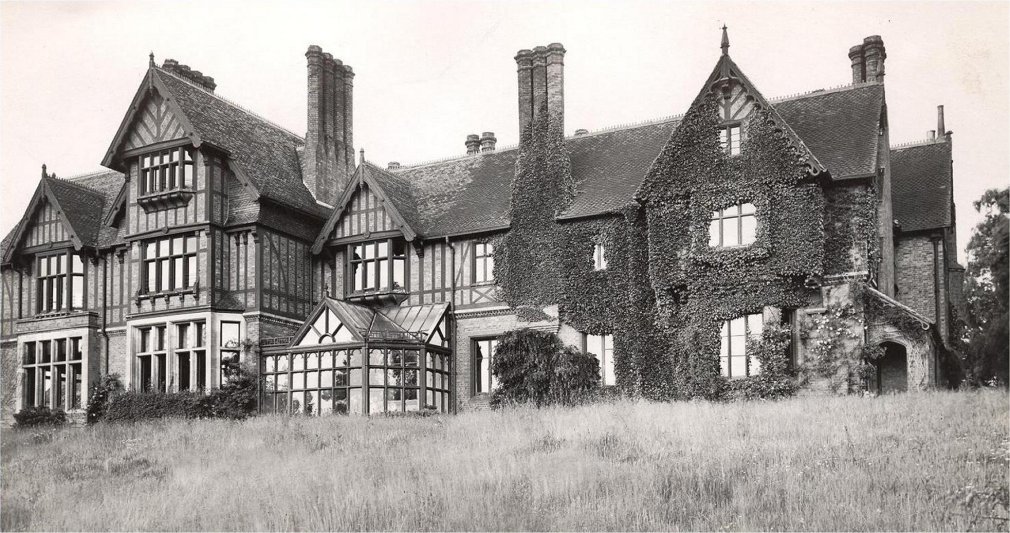SEARCH PHOTOGRAPHIC ARCHIVE


1946
Spratton Grange was built in 1847 as a hunting lodge in 246 acres of land. It was then known as Spratton Hill House. Its first occupant was Dowager Lady St. John. She let the separate farm, then known as Spratton Lodge Farm, and put this up for sale in 1850 (see 'Mercury' article 7 December 1850). She sold and moved circa 1856 (see 'Mercury' article 29 March 1856), when Edward and Dorothy Studd bought the house. Their son, Charles, the famous cricketer was born here in 1860. It is believed that the Studds may have left in 1866, possibly being bought by A A Berens Esq., who appears on the "Return of Owners of Land" of 1873. In 1878, it was acquired by W H Foster (Henry) and his wife Henrietta (nee Packingham-Mahn, see was an Irish C of E, so presumably Irish). He was a wealthy coalmine owner from Apsley in Shropshire. Henry Foster enlarged the house for his growing family. He had 3 daughters (Mabel, eldest born 1873, Dorothy probably youngest born 1889, and another one name and birth date not known - they became Mrs Goldburn, Mrs Belben, and Mrs Wood) and a son (Arthur William born 1884). W H Foster generously agreed to pay for the clock in the Spratton church tower to be installed in 1886. The family left Spratton when Mr. Foster's father (William Orne Foster) died in 1899 and Henry had to return to the family seat at Apley Park, Shropshire. He did not sell Spratton Grange but let it out to tenants for a number of years. The first tenant was the very wealthy Edward Moorhouse, who came with his New Zealand born wife in late 1900 or early 1901 (The Moorhouses had previously rented Lamport Hall from the Ishams from 8 November 1886 for 6 months to the end of April. Initially this was at a rent of £367.10.0 for the period. By 1891 the rental was £525 and Moorhouse was complaining about the regular increases). They were in the area for its hunting and it is known that Edward kept at least 12 hunters, all of which he had put down in 1914 rather than face the prospect of them being sent to the front. When they moved to Spratton, they had two daughters, Anne (15) and Mary (11) who were educated at home by a governess (Emily Davison, who was later to become the well known suffragette who died when she threw herself under the king's horse at the Derby in 1913). They also had two sons, William (13) away at Harrow and Edward who was 7 years old. The family kept a large staff of at least 12 servants as well as gardeners, grooms, stable hands and a coachman. Mrs Moorhouse and her daughters played an active part in village life, helping Lady Erskine run a girls' club and throwing open the gardens of the Grange for village functions.
In 1911, Mary sent a letter to all the girls named Mary in the village asking them for a contribution to a coronation gift for their namesake, the new Queen Mary. The family always headed the list of subscribers when money was needed for worthy causes such as the school building fund and the village street lighting. Indeed Mrs. Moorhouse sent generous donations for the church bells and repair of the church roof long after leaving the village in 1915.
The next tenant was a Mrs. Bryants, who let the place go to ruin. There are stories that even chickens were found wandering through the house and nesting in the billiard room.
In 1924 when Henry Foster died the son Major Arthur Foster (who had lost a leg in World War 1 and was unmarried and, reportedly, an 'unapproachable' man) inherited Apley and 'kicked' Henrietta out. She moved back to the Grange and had extensive work done on the house to restore it and lived in some style with a staff of 13 as well as keeping a chauffeur driven Daimler. She gave generously to requests for donations to village causes and was sadly missed when she died in 1939 aged 90 years.
The farm land was managed by a succession of bailiffs - Moses Reeve in 1871, Edward Thomas in 1881, James William in 1890 and Thomas Lewis in 1901. It was then let to Alfred Gilby in 1906 (or earlier), the Hammond family from 1925 (60% pasture, 40% arab
Image Reference: 0872
Related Searches: Houses | Spratton Grange | 1940
